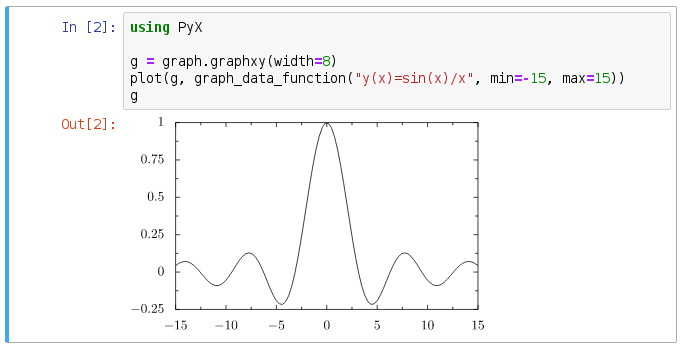PyX Graphics for Julia
This is a Julia wrapper of the PyX plotting and TeX graphics library from Python.
It is a work in progress, broken, and will set your computer on fire. See also the TODO file.
Source Code: https://github.com/bnewbold/PyX.jl
Travis CI: https://travis-ci.org/bnewbold/PyX.jl
Example
using PyX
g = graph.graphxy(width=8)
plot(g, graph_data_function("y(x)=sin(x)/x", min=-15, max=15))
writePDFfile(g, "example_graph.pdf")
Plotting works automagically from within Jupyter and other graphic interfaces:

There are many (ported) examples in the ./examples/ directory of this repository. See the Python PyX upstream documentation for example outputs: http://pyx.sourceforge.net/
For pipeGS (ghostscript file conversion) output "device" options, see: http://www.ghostscript.com/doc/current/Devices.htm
Dependencies and Python Version
You'll obviously need the underlying Python PyX library installed, plus any
dependencies (eg, LaTeX and Ghostscript). These are pretty huge and complex
packages to install! Use something like Debian's apt or Homebrew on OS X. No
idea how to get this set up on Windows or other platforms.
NOTE: PyX versions starting with 0.13 are Python3-only. PyX versions 0.12.1 and earlier are Python2-only. This split happened back in 2013. This wrapper will work with versions on either side of the split, but the newer versions (starting with PyX 0.14) support SVG and newer features. Unfortunately, switching Julia's PyCall wrapper from Python2 to Python3 is all or nothing. Careful! If you decide to do this, run:
julia> ENV["PYTHON"] = "/usr/bin/python3" # Or your local full path
julia> Pkg.build("PyCall")
Installation
This package is not (yet) listed in the official Julia MANIFEST.jl index, so you'll need to install it "unregistered" style:
julia> Pkg.clone("https://github.com/bnewbold/PyX.jl")
julia> using PyX
To run tests, do something like:
JULIA_LOAD_PATH=src julia test/runtests.jl
Differences from Python
All the expected Julia/Python differences apply:
- use Julia's
nothinginstead of Python'sNone - use 1-indexing instead of 0-indexing, and require
endin slice syntax - function calls like
writeEPSfile(c, filename)instead of object method calls likec.writeEPSfile(filename).
Note that the string code snippets that go into graph_data_function are still
Python code, not Julia.
There doesn't seem to be an easy way to handle nested Python modules as nested
modules in Julia, so there can only be a single . separator in variable and
function names. This has been worked around by using the underscore character
(_) instead of . for all but the last separator. So, eg,
graph_axis.split() instead of graph.axis.split() and color_rgb.red
instead of color.rgb.red.
To avoid namespace collisions or confusion with built-in Julia functions the
following functions (only) have pyx_ preprended to the function name:
pyx_fill, pyx_append, pyx_insert, pyx_text
function is also a reserved keyword in Julia, so use graph_data_function
instead of graph_data.function.
License
Following the license of the underlying PyX python library, this wrapper is licensed under the GNU GPL Version 2 (or later). See the LICENSE file, and the upstream licensing note: http://pyx.sourceforge.net/license.html
